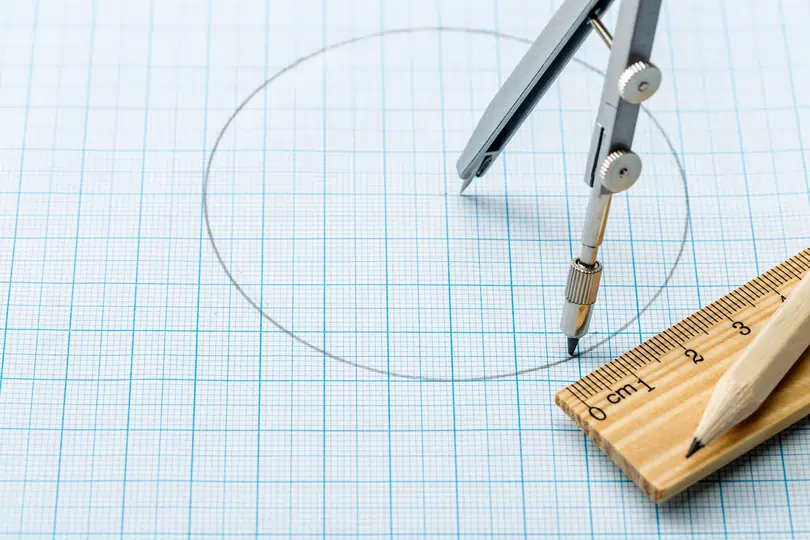Volume Of Cubes And Cuboid
Volume is the amount of space that is enclosed in a solid figure like a cube or a cuboid.
If we are given the dimensions of the cube/cuboid, we know how to calculate the volume by using the formula of
\(\small\mathsf{length \times breadth \times height} \)
At P6, we are given the volume of a cube/cuboid, and we have to find:
- find the length of the cube/cuboid.
- find the base area of the cube/cuboid.
- find the height of the cube/cuboid.
This article is written as per the course prescribed for Primary 6 Maths level.
This will provide you with a strong foundation and will help you build your concepts to be able to solve challenging questions related to this topic.
Volume Of Cube
A cube is a six-sided three-dimensional solid figure with square faces. All the edges of the cube are equal in length.

We know, that the volume of a cube is \(\small\mathsf{length \times breadth \times height} \).
Since, all the sides of the cube are the same, so
\(\small{\therefore \qquad \mathsf{length = breadth = height}}\).
\(\small\textsf{Volume of a cube} = \mathsf{length \times length \times length}\).
\(\small\textsf{Volume of a cube} = \mathsf{length^3}\)
So, to find the length of one edge of the cube, we find the cube root of volume.
\(\small\textsf{Length of one edge of a cube} = \sqrt [3]{\textsf{Volume}}\)
Volume Of Cuboid
A cuboid is a six-sided 3-dimensional solid figure with rectangular and/or square faces. The opposite faces of the cuboid are the same.
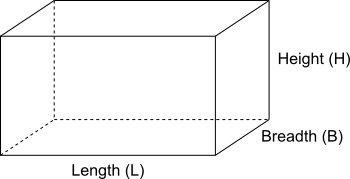
\(\small\textsf{Volume of a cuboid} = \mathsf{length \times breadth \times height}\)
\(\small\mathsf{V = L × B × H }\)

Now, if the volume, breadth and height are given, how do we find the Length?
We use the above triangle to help us with the formula.
\(\small \mathsf{L = V \div ( B \times H )}\)
Similarly, to find the breadth,
\(\small \mathsf{B = V ÷ (L × H)}\)
Lastly, to find the height,
\(\small \mathsf{H = V \div (L \times B)}\)
1. Finding the length of the edge of a cube/cuboid
Now that we have learned the formulae, let us try a few questions.
Question 1:
The volume of the cuboid below is \(\small \mathsf{340 \,cm^3}\). Find the length of the cuboid.
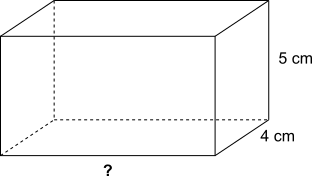
Solution:
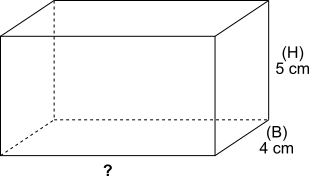
\(\begin{align} \small \mathsf{Length (L)} &= \small \,? \\ \small \mathsf{Breadth (B)} &= \small \mathsf{4\;cm} \\ \small \mathsf{Height (H)} &= \small \mathsf{5\;cm} \\ \small \mathsf{Volume (V)} &= \small \mathsf{340\;cm^3} \\[2ex] \end{align}\)
\(\begin{align} \small \mathsf{Length} &= \small \mathsf{Volume \div ( Breadth \times Height )} \\ &= \small \mathsf{340 \,cm^3 \div (4 \,cm \times 5 \,cm)}\\ &= \small \mathsf{340 \,cm^3 \div 20 \,cm^2}\\ &= \small \mathsf{17 \,cm} \end{align}\)
Answer:
\(\small\textsf{17 cm}\)
Question 2:
The volume of a cube is \(\small\mathsf{1331 \,cm^3}\). Find the length of the edge of the cube.
Solution:
\(\begin{align} \small\textsf{Volume (V)} &= \small\mathsf{1331\,cm^3} \\ \small\textsf{Length (L)} &=\small\textsf{?} \end{align} \)
\(\begin{align} \small\textsf{Length of the edge of the cube} &= \small\mathsf{\sqrt [3]{1331} \,cm^3}\\ &=\small\mathsf{11 \,cm} \end{align} \)
Answer:
\(\small\textsf{11 cm}\)
2. Finding the base area of a cube and a cuboid
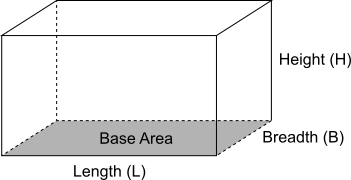
\(\small\textsf{Base area of a cuboid} = \mathsf{Length \times Breadth}\)
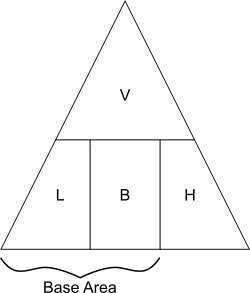
We use the same triangle to help us with the formula.
\(\small \mathsf{Base \;Area = V ÷ H}\)
Lastly, to find the height,
\(\small \mathsf{H = V ÷ Base \;Area}\)
Question 1:
A solid has a volume of \(\small \mathsf{1230 \;cm^3}\). If the height of the solid is \(\small \mathsf{6 \;cm}\), find the base area of the solid.
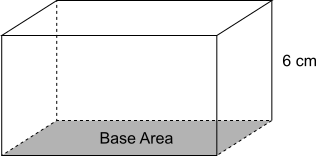
Solution:
\(\begin{align} \small\textsf{Volume of solid} &= \small\mathsf{1230 \,cm^3} \\ \small\textsf{Height of solid} &= \small\mathsf{6 \,cm} \end{align}\)
\(\begin{align} \small\textsf{Volume of solid} &= \small\mathsf{Length \times Breadth \times Height}\\ &=\small\mathsf{Base Area \times Height} \end{align}\)
\(\begin{align} \small\textsf{Base area of solid} &= \small\mathsf{Volume \div Height} \\ &= \small\mathsf{1230 \,cm^3 \div 6\,cm} \\ &= \small\mathsf{205 \,cm^2} \end{align}\)
Answer:
\(\small\mathsf{205 \,cm^2}\)
Question 2:
A solid has a volume of \(\small\mathsf{1688 \,cm^3}\). If the height of the solid is \(\small\mathsf{8\,cm}\), find the base area of the solid.

Solution:
\(\begin{align} \small\textsf{Volume of solid} &= \small\mathsf{1688 \,cm^3} \\ \small\textsf{Height of solid} &= \small\mathsf{8 \,cm} \end{align}\)
\(\begin{align} \small\textsf{Volume of solid} &= \small\mathsf{Length \times Breadth \times Height}\\ &=\small\mathsf{Base Area \times Height} \end{align}\)
\(\begin{align} \small\textsf{Base area of solid} &= \small\mathsf{Volume \div Height} \\ &= \small\mathsf{1688 \,cm^3 \div 8\,cm} \\ &= \small\mathsf{211 \,cm^2} \end{align}\)
Answer:
\(\small\mathsf{211 \,cm^2}\)
Question 3:
The volume of the cuboid is \(\small\mathsf{1048 \,cm^3}\) and the area of the shaded face is \(\small\mathsf{131 \,cm^2}\). Find the length of the unknown edge of the cuboid.
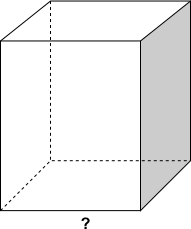
Solution:
\(\small{ \begin{align} \textsf{Volume} &= \mathsf{1048\,cm^3} \\ \textsf{Shaded area} &= \mathsf{131\,cm^2} \end{align}}\)
\(\small\bbox[8px,border:2px solid red] { \textsf{Volume} = \textsf{Shaded Area × Length} } \)
\(\small{ \begin{align} \textsf{Length of solid} &= \mathsf{Volume \div Shaded Area} \\ &= \mathsf{1048 \,cm^3 \div 131 \,cm^2} \\ &= \mathsf{8 \,cm} \end{align}}\)
Answer:
\(\small\textsf{8 cm}\)
3. Finding the height or water level of the container
Using the concepts learned thus far, let us try to solve the following questions.
Question 1:
A rectangular tank contains \(\small\mathsf{12.5 \,\ell}\) of water. If the base area of the tank is \(\small\mathsf{500 \;cm^2}\), what is the height of the water level of the tank? \(\small\mathsf{(1 \,\ell = 1000 \,cm^3)}\)
Solution:
\(\small{\begin{align} \mathsf{1\,\ell} &= \mathsf{1000 \,cm^3} \\ \mathsf{12.5 \,\ell} &= \mathsf{12.5 \times 1000 \,cm^3}\\ &= \mathsf{12 \,500 \,cm^3} \end{align}}\)
\(\small{\begin{align} \textsf{Volume of water in the tank} &= \mathsf{12\,500 \,cm^3} \\ \textsf{Base area of the tank} &= \mathsf{500 \,cm^2} \end{align}}\)
\(\small{ \bbox[8px, border:2px solid red]{ \textbf{Volume} = \textbf{Base Area × Height} }}\)
\(\small{\begin{align} \textsf{Height of water in the tank} &= \mathsf{12 \,500 \,cm^3 \div 500 \,cm^2} \\ &= \mathsf{25 \,cm} \end{align}}\)
Answer:
\(\small\text{25 cm}\)
Question 2:
A rectangular container had a base area of \(\small\displaystyle\mathsf{750 \,cm^2}\). Sally poured some mango syrup into the container till it was \(\small\displaystyle\mathsf{\frac {3}{8}}\) full. She then poured \(\small\displaystyle\mathsf{11\frac {1}{4}}\) litres of water into the container until it was completely full. What was the height of the rectangular container?
Solution:
\(\small{ \begin{align} \mathsf{1 \,litre} &= \mathsf{1000 \,cm^3} \\ \mathsf{11\frac{1}{4} \textsf{ litres of water}} &= \mathsf{11.25 × 1000 \,cm^3} \\ &= \mathsf{11 \,250 \,cm^3} \end{align} }\)a
\(\small{ \begin{align} \textsf{Volume of the full container} &= \textsf{Volume of mango syrup} \\ & \qquad\quad + \\ & \quad\, \textsf{Volume of water} \end{align} }\)
\(\small{ \begin{align} \textsf{Volume of mango syrup} &= \mathsf{\frac{3}{8}} \textsf{ of total Volume}\\ \textsf{Volume of water} &= \mathsf{1-\frac{3}{8}}\\ &=\mathsf{\frac{5}{8}} \textsf{ of total volume} \end{align} }\)
\(\small{ \begin{align} \mathsf{\frac {5}{8} \textsf{ of total volume}} &= \mathsf{11\,250 \,cm^3} \\ \mathsf{\frac {1}{8} \textsf{ of total volume}} &= \mathsf{11\,250 \,cm^3 \div 5}\\ &= \mathsf{2250 \,cm^3} \end{align} }\)
\(\small{ \begin{align} \mathsf{\frac {3}{8} \textsf{ of total volume}} &= \mathsf{2250 \,cm^3 \times 8}\\ &= \mathsf{18\,000 \,cm^3} \end{align} }\)
\(\small{ \begin{align} \textsf{Height of the container} &= \mathsf{Volume \div Base Area} \\ &= \mathsf{18\,000 \,cm^3 ÷ 750 \,cm^2} \\ &= \mathsf{24 \,cm} \end{align} }\)
Answer:
\(\small{\textsf{24 cm}}\)
Practice Questions
Question 1:
The shaded face of the cuboid is a square. The length of the cuboid is \(\small{\textsf{12 m}}\) and its volume is \(\small{\mathsf{1452 \,m^3}}\). Find the length of one side of the square face.
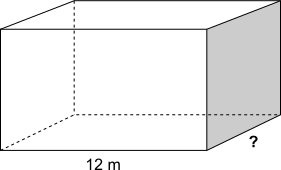
Solution:
\(\small{ \begin{align} \textsf{Volume of cuboid} &= \textsf{Length × Breadth × Height} \\ &= \textsf{Area of the shaded face × Height} \end{align}}\)
\(\small{ \begin{align} \textsf{Area of the square face} &= \textsf{Volume ÷ Height}\\ &= \mathsf{1452 \,m^3 ÷ 12 \,m}\\ &= \mathsf{121 \,m^2} \end{align}}\)
\(\small{ \begin{align} &\textsf{Since, the shaded face of the cuboid is a square, then }\\ &\textsf{Length} = \textsf{Breadth} \end{align}}\)
\(\small{ \begin{align} \textsf{Area of the square} &= \textsf{Length × Length} \\ \textsf{Length} &= \mathsf{\sqrt{121} m^2} \\ &= \mathsf{11 \,m} \end{align}}\)
Answer:
\(\small{\textsf{11 m}}\)
Question 2:
The shaded face of a cuboid is a square. The length of a cuboid is \(\small{\textsf{28 cm}}\) and its volume is \(\small{\mathsf{1008 \,cm^3}}\). Find the length of one side of the square face.
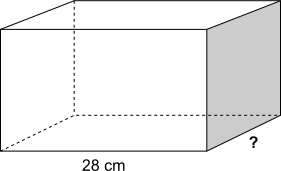
Solution:
\(\small{\begin{align} \textsf{Volume of a cuboid} &= \mathsf{Length \times Breadth \times Height}\\ &=\mathsf{Length \times \textsf{Area of the shaded square}} \end{align}}\)
\(\small{\begin{align} \textsf{Area of the square base} &= \mathsf{Volume \div Length} \\ &= \mathsf{1008 \,cm^3 \div 28 \,cm} \\ &= \mathsf{36 \,cm^2} \end{align}}\)
\(\small{\begin{align} \textsf{Side of the square} &= \mathsf{\sqrt{36} \,cm^2} \\ &= \mathsf{6 \,cm} \end{align}}\)
Answer:
\(\small{\textsf{6 cm}}\)
Question 3:
Sam filled a rectangular tank with a square base partially filled with water, as shown in the figure below. The volume of the water in the tank is \(\small{\mathsf{972 \,cm^3}}\). Find the length of the rectangular tank.

Solution:
\(\small{\begin{align} \textsf{Volume of water} &= \mathsf{972 \,cm^3} \end{align}}\)
\(\small\bbox[8px,border:2px solid red] { \textbf{Volume of the water} = \textbf{Base area × Height} } \)
\(\small{\begin{align} \textsf{Base area of the tank} &= \textsf{Volume ÷ Height} \\ &= \mathsf{972 \,cm^3 \div 12 \,cm} \\ &= \mathsf{81 \,cm^2} \end{align}}\)
\(\small{\begin{align} \textsf{Side of the square base} &= \mathsf{\sqrt{81} \,cm^2} \\ &= \mathsf{9 \,cm} \end{align}}\)
\(\small{\begin{align} \textsf{Length of the rectangular tank} &= \mathsf{9 \,cm} \end{align}}\)
Answer:
\(\small{\textsf{9 cm}}\)
Question 4:
The area of one of the faces of a cube is \(\small{\mathsf{144 \,cm^2}}\). What is the volume of four such cubes?
Solution:
\(\small{\begin{align} \textsf{Side of the cube} &= \mathsf{\sqrt{144} \,cm} \\ &= \mathsf{12 \,cm} \end{align}}\)
\(\small{\begin{align} \textsf{Volume of each cube} &= \textsf{Length × Breadth × Height}\\ &= \mathsf{12 \,cm \times 12 \,cm \times 12 \,cm}\\ &= \mathsf{1728 \,cm^3} \end{align}}\)
\(\small{\begin{align} \textsf{Volume of four cubes} &= \mathsf{4 \times 1728 \,cm^3} \\ &= \mathsf{6912 \,cm^3} \end{align}}\)
Answer:
\(\small{\mathsf{6912 \,cm^3}}\)
Summary
In Primary 6 Maths Volume, we need to know the following:
- How to calculate the volume of a cube/cuboid?
- Given the volume of a cube or cuboid, how can we find out the unknown side?
- Given the volume of a cube or cuboid, how to find the area of one of the faces of the cube or cuboid?
- Given the volume of the cube and the area of one face, how to find the unknown side?
- Given the volume of water in a rectangular/cubical tank, how to find the unknown side?
Remember, practice is the key to perfection.
| Continue Learning | |
|---|---|
| Algebra | Distance, Speed and Time |
| Volume of Cubes and Cuboid | Fundamentals Of Pie Chart |
| Finding Unknown Angles | Number Patterns: Grouping & Common Difference |
| Fractions Of Remainder | Fractions - Division |
| Ratio | Repeated Identity: Ratio Strategies |
Test Yourself
The base of a fish tank measures 32 cm by 28 cm. Its volume is 10880 cm³ when it is 5/7 full of water. Find the height of the fish tank.
Ans: (1) 17 cm
Peter wants to fill up his rectangular water tank measuring 150 cm by 30 cm by 40 cm to its brim. 5 litres of water flows out from Tap A per minute and 4 litres of water flows out from Tap B per minute. If both taps are turned on at the same time how long does it take to fill up the whole tank?
Ans: (2) 20 min
Two cubes are glued together to form a solid as shown in the figure below. All the faces of the solid are painted. The total surface area painted is 90 cm². Find the volume of one cube.
Ans: (2) 27 cm³




 SG
SG  VN
VN 



